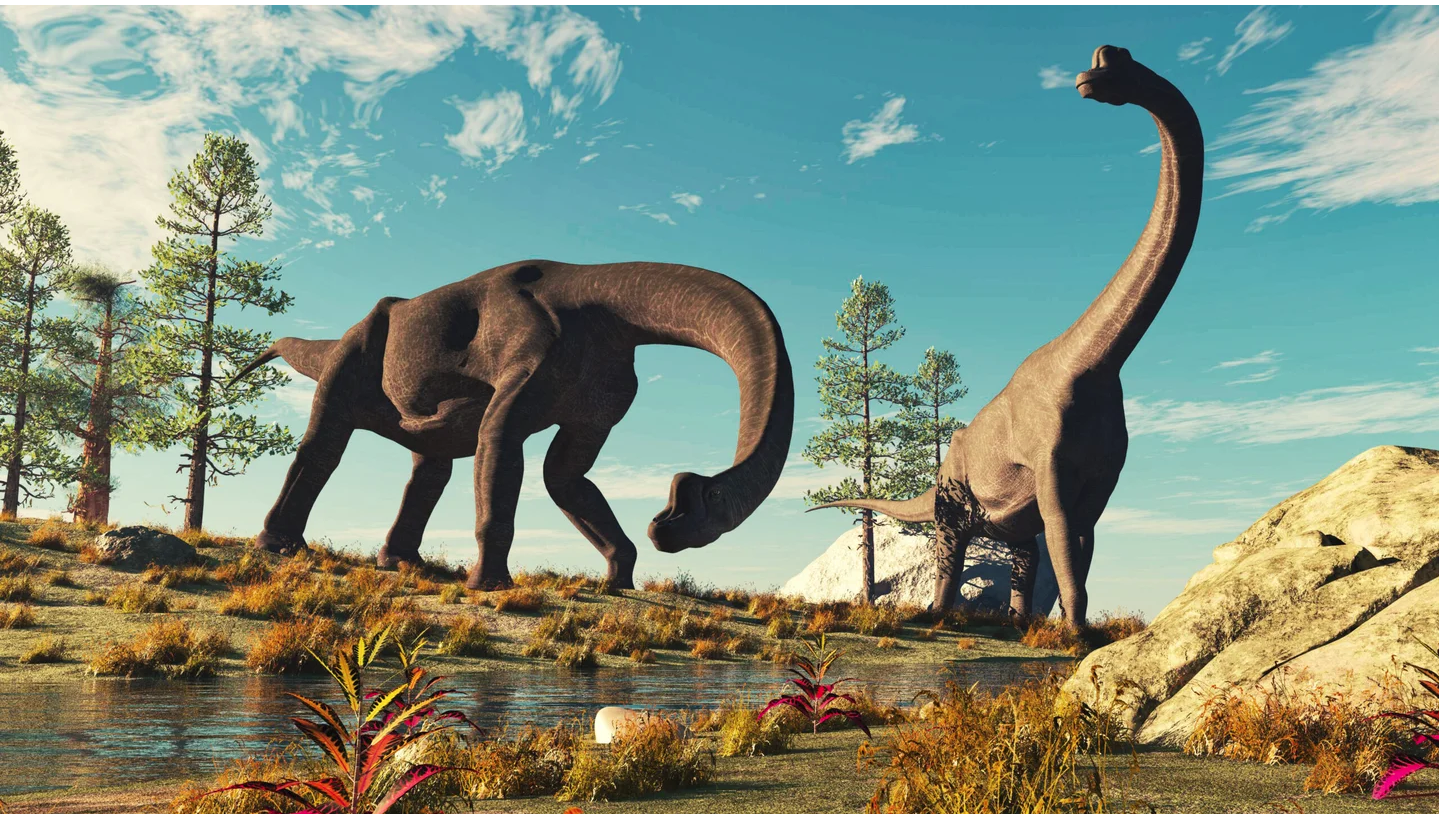To watch a giraffe drinking is to observe the problem of a long neck. It must require a peristaltic pump that could drain a swimming pool. And don’t talk about the air pump strong enough to prevent hypoxia (oxygen starvation). In the long-necked department, however, giraffes are historically a doddle.
 These giraffes of the dry Hoarusib riverbed, northern Namibia, survive the harshest of conditions nature has to offer. Taken 29th May 2021. Jacky du Plessis
These giraffes of the dry Hoarusib riverbed, northern Namibia, survive the harshest of conditions nature has to offer. Taken 29th May 2021. Jacky du Plessis
Take, for instance, the sauropod.
They’re those creatures with elephant-like bodies, elongated front legs, whiplash tails and snaky necks beloved of children’s toy boxes. The mechanical problems of such an outrageous neck extension are considerable. But whatever the barriers to the evolution of long necks in other vertebrates, sauropods didn’t just break that barrier – they smashed it.
 The excavation campaign at the Monte Agudo paleontological site in Portugal. Image: Supplied / Instituto Dom Luiz University of Lisbon
The excavation campaign at the Monte Agudo paleontological site in Portugal. Image: Supplied / Instituto Dom Luiz University of Lisbon
One has just been unearthed by paleontologists in a backyard in Pombal, Portugal, that measures 25m nose to tail. Scaling up from cervical vertebrae that have been found, there are Jurassic beasties that could have had 16.5m necks.
Before considering the physical problems, we have to ask why they needed them, because neckfulness must have had an evolutionary advantage. To reach food is the obvious answer – giraffes browse the tops of trees – but sauropod necks were more horizontal than vertical (which is why they needed long tails as balance).
 Skeletons of some long-necked non-sauropods. Michael Taylor @ Matthew Wedel / Creative Commons.
Skeletons of some long-necked non-sauropods. Michael Taylor @ Matthew Wedel / Creative Commons.
It’s been established that they were most likely vegetarians weighing many tonnes, making unnecessary exertion a hassle. A long neck would allow them to chomp without moving much. But its weight must have been a problem nature had to solve.
How? First they had relatively small heads containing cat-sized brains – really just a mouth with eyes. But bones are heavy. Whereas modern mammals have seven neck vertebrae, sauropods had up to 25. The solution was “bone foam”, an interior lattice that was strong but light. Unlike the uber-hunter Tyrannosaurus rex which had solid bones for pouncing and crunching, the bones of sauropods were more like those of today’s birds.
 Brachiosaurus altithorax which was animated in the 1993 movie Jurassic Park. Michael Taylor @ Matthew Wedel / Creative Commons.
Brachiosaurus altithorax which was animated in the 1993 movie Jurassic Park. Michael Taylor @ Matthew Wedel / Creative Commons.
Their heads were also lightened by reduced dentition. They wouldn’t have processed food in their mouths as we do, but just ripped and shoved it down the hatch for peristalsis to deal with. They were simple cropping devices, unlike giraffes which have a heavy chewing machine atop a neck, limiting their length.
That wasn’t the whole story: long necks were still heavy and this created other problems – like balance. Anyone who’s seen the film Jurassic Park will remember lumbering sauropods with massive forelimbs, blobby bodies and endless tails. Over millions of years, natural selection would have refined their shape to make that possible.
https://www.youtube.com/watch?v=fb5ELWi-ekk
Their front legs would have been ahead of a mid-body pivot point which prevented the creatures from tipping onto their chins. Those tails were there for the same reason and their rotund bodies would have contained large muscles attached to their ribs and spine to enable an operational front end.
None of this solved breathing, however, a limiting factor in neck length being the difficulty of the efficient use of air through a long trachea. A long neck could have created “tracheal dead space”, with exhaled breath not being fully expelled but re-inhaled, reducing essential oxygen. The solution would have to have been very efficient, voluminous lungs with extremely efficient air sacs, something we see in long-necked birds such as herons.
 Necks of long-necked creatures to scale. Michael Taylor @ Matthew Wedel / Creative Commons.
Necks of long-necked creatures to scale. Michael Taylor @ Matthew Wedel / Creative Commons.
 Long-necked sauropods to scale. Michael Taylor @ Matthew Wedel / Creative Commons.
Long-necked sauropods to scale. Michael Taylor @ Matthew Wedel / Creative Commons.
Although the necks of giraffes are the longest of any mammals, they are shorter by a factor of six than those of the longest sauropods. This is because giraffes have relatively small torsos, large, heavy heads, only seven cervical vertebrae, no air-sac system, and no foamy bones. And because their necks are vertical, they have puny tails with no value other than flipping flies. Even by today’s standards, they are relatively short-necked creatures. There are others…
Sauropods died out, but nature never wastes a good experiment. Long necks, compact bodies and balancing tails just happened to be streamlined. Millions of years, considerable shrinkage and much experimentation later, the forelegs became wings and the skin grew feathers. If you want to see a Supersaurus in action take a look at one of its glorious descendants – a swan. Now there’s a neck to marvel at. DM/ML
Visit Daily Maverick's home page for more news, analysis and investigations




 Long-necked sauropods to scale. Michael Taylor @ Matthew Wedel / Creative Commons.
Long-necked sauropods to scale. Michael Taylor @ Matthew Wedel / Creative Commons. 